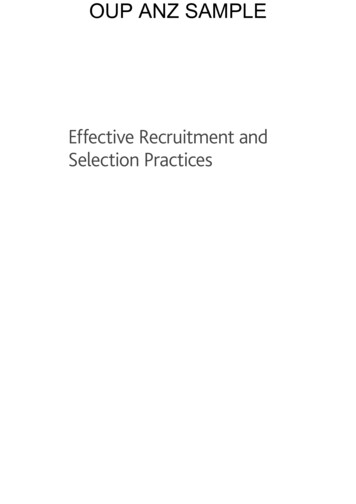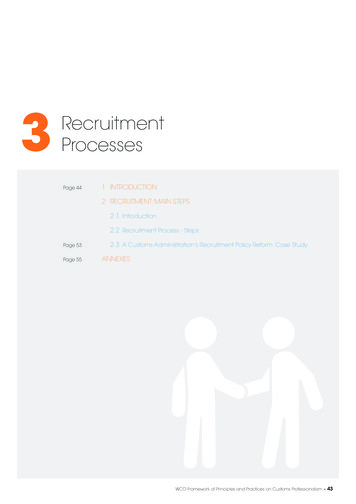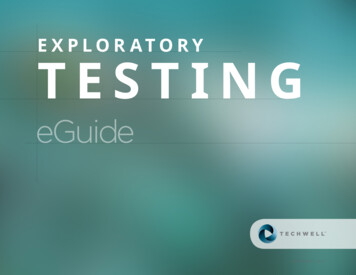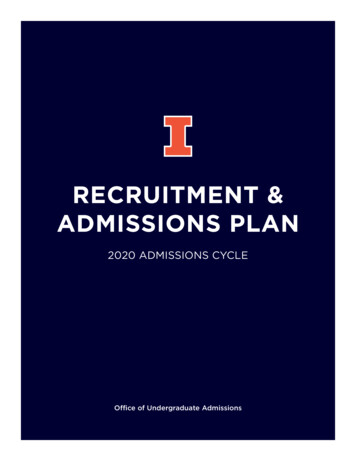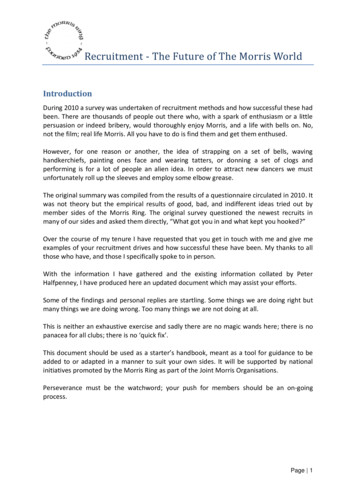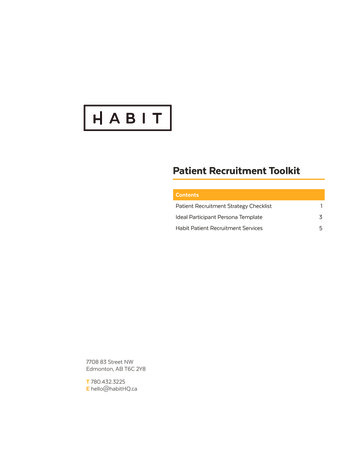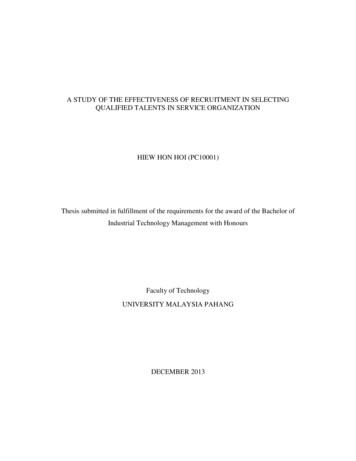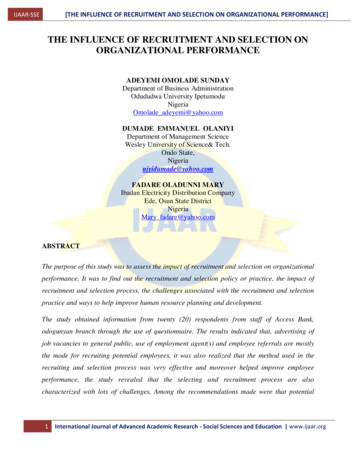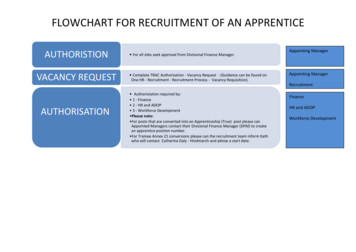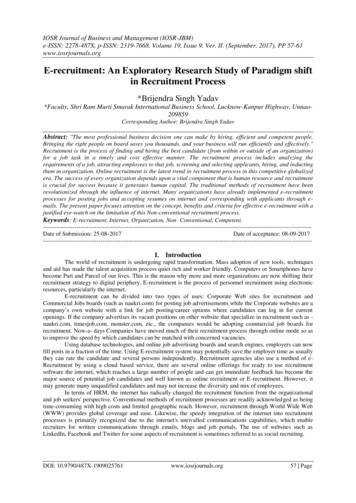
Transcription
IOSR Journal of Business and Management (IOSR-JBM)e-ISSN: 2278-487X, p-ISSN: 2319-7668. Volume 19, Issue 9. Ver. II. (September. 2017), PP 57-61www.iosrjournals.orgE-recruitment: An Exploratory Research Study of Paradigm shiftin Recruitment Process*Brijendra Singh Yadav*Faculty, Shri Ram Murti Smarak International Business School, Lucknow-Kanpur Highway, Unnao209859Corresponding Author: Brijendra Singh YadavAbstract: ''The most professional business decision one can make by hiring, efficient and competent people.Bringing the right people on board saves you thousands, and your business will run efficiently and effectively."Recruitment is the process of finding and hiring the best candidate (from within or outside of an organization)for a job task in a timely and cost effective manner. The recruitment process includes analyzing therequirements of a job, attracting employees to that job, screening and selecting applicants, hiring, and inductingthem in organization. Online recruitment is the latest trend in recruitment process in this competitive globalizedera. The success of every organization depends upon a vital component that is human resource and recruitmentis crucial for success because it generates human capital. The traditional methods of recruitment have beenrevolutionized through the influence of internet. Many organizations have already implemented e-recruitmentprocesses for posting jobs and accepting resumes on internet and corresponding with applicants through emails. The present paper focuses attention on the concept, benefits and criteria for effective e-recruitment with ajustified eye-watch on the limitation of this Non-conventional recruitment process.Keywords: E-recruitment, Internet, Organization, Non- Conventional, ----------------------------------- ---------Date of Submission: 25-08-2017Date of acceptance: ----------------------------------- ----------I. IntroductionThe world of recruitment is undergoing rapid transformation. Mass adoption of new tools, techniquesand aid has made the talent acquisition process quiet rich and worker friendly. Computers or Smartphones havebecome Part and Parcel of our lives. This is the reason why more and more organizations are now shifting theirrecruitment strategy to digital periphery. E-recruitment is the process of personnel recruitment using electronicresources, particularly the internet.E-recruitment can be divided into two types of uses: Corporate Web sites for recruitment andCommercial Jobs boards (such as naukri.com) for posting job advertisements while the Corporate websites are acompany’s own website with a link for job posting/career options where candidates can log in for currentopenings. If the company advertises its vacant positions on other website that specialize in recruitment such as naukri.com, timesjob.com, monster.com, etc., the companies would be adopting commercial job boards forrecruitment. Now-a- days Companies have moved much of their recruitment process through online mode so asto improve the speed by which candidates can be matched with concerned vacancies.Using database technologies, and online job advertising boards and search engines, employers can nowfill posts in a fraction of the time. Using E-recruitment system may potentially save the employer time as usuallythey can rate the candidate and several persons independently. Recruitment agencies also use a method of eRecruitment by using a cloud based service, there are several online offerings for ready to use recruitmentsoftware the internet, which reaches a large number of people and can get immediate feedback has become themajor source of potential job candidates and well known as online recruitment or E-recruitment. However, itmay generate many unqualified candidates and may not increase the diversity and mix of employees.In terms of HRM, the internet has radically changed the recruitment function from the organizationaland job seekers' perspective. Conventional methods of recruitment processes are readily acknowledged as beingtime-consuming with high costs and limited geographic reach. However, recruitment through World Wide Web(WWW) provides global coverage and ease. Likewise, the speedy integration of the internet into recruitmentprocesses is primarily recognized due to the internet's unrivalled communications capabilities, which enablerecruiters for written communications through emails, blogs and job portals. The use of websites such asLinkedIn, Facebook and Twitter for some aspects of recruitment is sometimes referred to as social recruiting.DOI: 10.9790/487X-1909025761www.iosrjournals.org57 Page
E-recruitment: An Exploratory Research Study of Paradigm shift in Recruitment ProcessII. Research MethodologyExploratory research approach is conducted to pursue present research and various articles, journals, reports andother write-ups have been studied in this regard.III. Literature ReviewParry & Wilson (2009) stated that “recruitment includes those practices and activities carried out by theorganization with the primary purpose of identifying and attracting potential employees”. E-recruitment emergesas a handy and advantageous method over traditional methods of recruitment (Tong and Sivanand 2005).Online recruiting can also produce cost savings and higher applicant earnings. Companies havereported savings of 95% when changing from modern to online recruiting causes and discrete companies havegenerated as many as 10,000 applicants through their recruitment web sites to fill less than 1000 jobs. (Cober etal., 2000)A survey conducted by marketresearch.com (2006), on the E-Recruitment market, found that the, majortrends of e-recruitment were: 1. More advanced tools for candidate management on corporate career sites; 2.Increasing use of social networking technologies (Facebook, LinkedIn) to reach candidates; and 3. Moreopportunities for specialists in the market.Maurer and Liu (2007) ‘web-based recruitment protects cost up to 87% per new employee employedby an organization’.Parry and Tyson (2008) conducted a study on the recruitment activities of establishments for a periodof six years with the use of survey and interview methods, questions were asked as to why the respondentsexploited or did not employ online recruitment, whether they predicted their use of the Internet for recruitmentto change, and what impact they expected Internet recruitment to have on the use of other recruitment methods.Avinash S. Kapse (2012) published an article about E recruitment which stated that online recruitmenthas many advantages to companies like low cost, less time, quick, wider area, better match and along with thisthey have highlighted some points of disadvantages of online recruitment like scrutinizing applications is aproblem, lack of internet awareness in India in some places and they said that employers want to have face toface interaction with candidates.Haroon and Zia-ur-Rehman (2010) also investigated online recruitment in Pakistan. A total of sixtyfive (65) respondents from small and large firms of the different sectors of the industries in Pakistan participatedin the study. Data were collected through telephone interviews showed that preference was given to small firmsas compared to large firms in terms of using internet recruitment.IV. Objectives1. To mark the benefits and limitations of E-recruitment.2. To enlist the methods and trends in E-recruitment.3. To draw out the factors criteria for ideal E-recruitment.V. Forms of RecruitmentForms of recruitment can be broadly categorized into two. One is Centralized and the other is Decentralized.5.1 Centralized recruitment happens where the organization is having a centralized power and authority withone person or department in decision making. It more easily can be seen in public sectors like State Bank ofIndia. The advantages may be Control of the administrative costs, standardization in the process, minimizesbiased choice and involvement of experts only.5.2 Decentralized recruitment is having authority to each department to choose their staff. The companies whoare geographically spread, or are much big in size will find this form convenient. Cost benefit analysis willdetermine the source of recruitment. Advertisements are considered to be most effective and common part ofrecruitment process through Newspaper, Magazines/ Journals. On line advertisements for recruitment is aminute part in this form of E-recruitment.VI. Why E-Recruitment?E-recruitment can overcome the barriers of conventional recruitment methods for easy access of thecandidates. To ensure oneself as sustainable Organization; the position recruiting high caliber staff isfundamental. Many employers are now seeking the prospective employees globally with no restrictions on thegeographical part. The same applies to be rue for prospective job seekers. They also search and apply for jobs inareas where their skills are in demand regardless of geographical location. This is the ‘Mool- Mantra’ of greatsuccess of e-recruitment strategy for gaining popularity in a shorter span of time.DOI: 10.9790/487X-1909025761www.iosrjournals.org58 Page
E-recruitment: An Exploratory Research Study of Paradigm shift in Recruitment ProcessVII.Advantages of E-Recruitment7.1. Less Time consumption in hiring: E-Recruitment allows for 24x7 hiring/job search activity. Employerscan post a job in as little as 20 minutes on a career site such as naukri.com and start receiving CVs in responseimmediately. The posting typically remains active for as long as 30 days and continues to receive applicant CVsimmediately as job seekers come across it. This is in comparison to traditional methods where a newspaper admay take appear a week later and only for a day, or a recruiter has to wait till month-end to reap the benefits ofan ad in a monthly industry or geography-specific publication.7.2. More Economical: Costs of posting jobs and/or searching for candidates on job portals can be up to 90%lower than the costs of using traditional search firms and/or advertising methods.7.3. Wider accessibility for candidates: Candidates benefit immensely from the wider scope they gain throughonline job sites. They are able to access jobs in companies and can apply immediately with a mere clicking ofmouse.7.4. Great Sorting and Filtration Tool: More online job sites offer unique search criteria and state-of-the-artscreening, sorting and filtration tools to help them quickly and easily target and contact both active and passiveprofessionals without any delay of time.7.5. Branding opportunity for employers: Employers can use their job ads to project a consistent brand andcompany image/values to prospective job seekers.7.6. Easy tracking facility: The entire recruitment process is managed from one location which allows theemployer to post vacancies, receive CVs, screen, prioritize and contact candidates individually or collectivelyand track all activities from the confines of a private and highly functional employer Workspace. Job seekerssimilarly can track the progress of their application at every stage of the hiring process from their ownfunctional workspace.VIII.Limitations of E-Recruitment8.1. Requirement of being computer friendly: As the search is based on various websites, their screening,keywords application demands for a computer savvy person and company.8.2. Legal consequences: Alike other recruitment sources this source also should be aware of the words used inthe advertisements otherwise it may lead to the charge of discrimination. For example, Disney World was suedfor screening the resumes preferring the key words used by whites.8.3. Big pool of applicants: Since the huge database cannot be scanned in depth so either first few candidatesare called for interview or the resumes are screened based on some key words. On the other hand applicants alsoface global competition.8.4. Non-serious applicants: Lot of applicants forward their resumes just to know their market value. At thetime of interview the recruiter might realize that the candidate is not serious in leaving the current job. It is a bigloss of time and money for the employer.8.5. High perceived risk in Disclosure of information: Candidates profile and company details are available topublic. The applicants do not want their employer to know that they are looking for a change. Phone number,address information has lead to many security problems. Again the companies do not want their competitorsalways to know the current scenario.8.6. Outdated job postings: Occasionally, human resource representatives fail to remove old postings forpositions from the website that have been filled. Sometimes this is due to miscommunication between the hiringmanager and HR or a lacuna in the system.8.7. Website malfunctioning: Applicants often complain about the technical functioning of the companywebsites that usually breakdowns when candidate sits to submit their documents. The websites sometimes are socomplex in look that even many icons do not get displayed at time.8.8. No response from the company: Another popular complaint from job applicants is, they don’t getresponses from some companies where they’ve submitted their resume and contact information to the companywebsite.IX. E-Recruiting Methods9.1 Job boards: These are the places where the employers post jobs with an aim of searching the prospectiveemployees. One of the disadvantages is, it is generic in nature.9.2 Employer web sites: These sites can be of the company owned sites, or a site developed by variousemployers.9.3 Professional websites: These are for posting the job vacancies for the specific professions and skills. LikeHR jobs Human Resource Management sites to be visited like www.shrm.org.DOI: 10.9790/487X-1909025761www.iosrjournals.org59 Page
E-recruitment: An Exploratory Research Study of Paradigm shift in Recruitment ProcessX. E-Recruitment TrendsSocial Media finds an indispensable place in today’s e-recruitment age. While earlier recruiters weredependent solely on the candidate’s resume, today they can easily perform a web search and find moreinformation about them by scouting their social media profiles, and also examine their work samples, allthrough the use of web.Further, while using social media as an immensely helpful platform for recruiters, the job seeker is alsoat advantage here as he has more opportunities today to find the right job than he had ever before. More thanhalf of the internet users now access the web from mobile devices in search of prospective workplace.According to a recent LinkedIn survey, 59% of the candidates are using mobile to search for vacanciesand 52% are using mobile to apply. However, these stats wouldn’t matter if you do not have a well-developedmobile recruitment strategy at first place. XI. Criteria for Ideal E-RecruitmentThe requirement for it is to benefit the selection procedure and make it simple. Thus to make the processeffective, the Organizations should be much concerned about various factors importantly Return oninvestment (ROI) which should be calculated to compare the costs and risks. It facilitates to evaluatebenefits and to calculate the estimated return on it.Recruitment policy should be flexible and proactive to go hand in hand with the market changes.Unemployment rate, labor turnover rate are considered. As the whole process depends on the availability ofcandidates in the market. For every post, position it is not viable to spend too much of time. These rates willdetermine whether to be stringent or lenient.Impact of supplying compensation details to be considered. That is the wage, salary, benefits, whendisclosed on line then it should follow the legal norms. Chance for negotiation will not be there.Compensation rate of the company not only reaches to the candidates but will be known to all.Precautions to be taken for resume screening. Words that discriminates gender, age, religion etc to beavoided.Review the results periodically and also update regularly to achieve a better result.Organizations need to be selective while choosing the sites especially in case of requirement of specificskill candidates and in this regard then the generic job search sites to be avoided.XII.12. ConclusionConventional methods should not be replaced by the E-recruitment, but it may go move ahead as a greatersupplement with a bright scope in future.The loopholes of e-recruitment can be covered by the traditional methods and recruitment process will befaster and global due to e-recruitment.When two vacancies are there and two candidates are available the companies do not have much choice,thus they prefer to widen their search and attracts numerous applications. But when for two vacancies acompany receive 2000 application, the in depth screening process is not possible. While other methods likecampus interview, internal search has a personal touch. But receiving application in hand, communicatingwith candidates becomes time consuming without internet. No doubt there has been a paradigm shift in therecruitment process by companies and the credit goes to the value, efficacy and ease of using today's careersites.As the use of internet is indispensable physical boundaries are blending and when it comes to professionalmobility and the hunt for talented and skilled workforce at peak level in regional economies this medium isdefinitely here to stay for long.Since every employer needs less cost input and less time consumption in recruitment process then for surethis method is going to be the first choice of all the stakeholders.Undoubtedly the future of E-recruitment method and technique is bright and shining as a need of this digitalage.References[1][2][3][4][5]Avinash S. Kapse Vishal, Patil S, Nikhil Patil V., E- Recruitment, International Journal of Engineering and Advanced Technology.(IJEAT) ISSN: 2249 – 8958, April, 2012, 1(4).Dhobale R (2010), “Role of Internet in HRM”, HRM Review, pp. 10-16.Dileep K M and Ramesh M (2009), “E-Recruitment: Leveraging Technology towards Business Excellence”, Business Review, Vol.4, No. 1 & 2, pp. 75-94.Dr. R. Ramaabaanu1 & M. Saranya. Importance and Problems of E- Recruitment, International Journal of Research (IJR). ISSN23486848, October, 2014, 1(9).Galanaki E (2002), “The Decision to recruit Online: A Descriptive Study”, Career International Development, Vol. 7, No. 4, pp.243-251.DOI: 10.9790/487X-1909025761www.iosrjournals.org60 Page
E-recruitment: An Exploratory Research Study of Paradigm shift in Recruitment Process[6][7][8][9][10]Kinder T (2000), “The use of the Internet in Recruitment- Case Studies from West Lothian, Scotland”, Technovation, Vol. 20, 461475.Maurer S D and Liu Y (2007), “Developing Effective E-Recruitment Websites: Insights for Managers from Marketers”, BusinessHorizons, Vol. 50, pp. 305-314.Thompson L F, Braddy W p and Wuensch K L (2008), “E-Recruitment and the Benefits of Organizational Web Appeal”,Computers in Human Behavior, Vol. 24, pp. 2384-2398.Tong D Y K (2009), “A Study of E-Recruitment Technology Adoption in Malaysia”, Industrial management and data Systems, Vol.109, No. 2, pp. 281-300.Verhoeven H and Williams S (2008), “Advantages and Disadvantages of Internet Recruitment: A UK Study into Employers’Perceptions”, International Review of Business Research Papers, Vol. 4, No. 1, pp. 364-373IOSR Journal of Business and Management (IOSR-JBM) is UGC approved Journal with Sl.No. 4481, Journal no. 46879.Brijendra Singh Yadav. “E-Recruitment: An Exploratory Research Study of Paradigm shift inRecruitment Process.” IOSR Journal of Business and Management (IOSR-JBM) , vol. 19, no.9, 2017, pp. 57–61.DOI: 10.9790/487X-1909025761www.iosrjournals.org61 Page
E-recruitment: An Exploratory Research Study of Paradigm shift in Recruitment Process DOI: 10.9790/487X-1909025761 www.iosrjournals.org 58 Page
